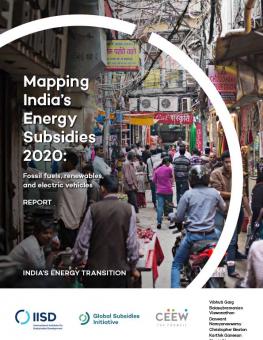
Mapping India's Energy Subsidies 2020: Fossil fuels, renewables and electric vehicles
How have India’s energy subsidy policies changed? What have been the most significant developments in India’s dynamic energy policy environment? And is public support aligned with India’s desired energy future?
Key Messages
- Shift public resources to a cleaner future. India’s progress since FY 2014 shows a commitment to the energy transition, driven at least in part by specific actions to reform perverse subsidies and back clean energy—but further efforts are required to shift public resources away from fossil fuels and toward clean energy.
- Align health and economic coping strategies with the desired energy future. India should prioritize health and economic recovery as it navigates the COVID-19 crisis—but clean energy transition can and should be reflected in coping strategies and support measures.
- Track and evaluate energy subsidy policies more systematically. Subsidy reporting can be conducted in line with formal guidelines for Sustainable Development Goal 12(c)1 and India’s G20 peer review of fossil fuel subsidies. With fuller data, ministries should monitor, evaluate, and adapt their most significant subsidies to better meet policy objectives.
Subsidies matter because they are used by governments around the world to influence energy producers and consumers. Mapping India’s Energy Subsidies 2020: Fossil fuels, renewables, electric vehicles examines how the Government of India (GoI) has used subsidies to support different types of energy, highlighting the most significant developments from FY 2014 to FY 2019. We seek to answer: How have India’s energy subsidy policies changed? What have been the most significant developments in India’s dynamic energy policy environment? And is public support aligned with India’s desired energy future?
The report is accompanied by an online data portal to help browse the subsidy data in detail and includes detailed spreadsheets and annexes for policy-makers and researchers. The analysis is the latest update in the India's Energy Transition series from the International Institute for Sustainable Development's (IISD) Global Subsidies Initiative (GSI) and Council on Energy, Environment and Water (CEEW). For previous iterations of this study, see:
- India's Energy Transition: Subsidies for Fossil Fuels and Renewable Energy, 2018 Update
- India's Energy Transition: Mapping subsidies to fossil fuels and clean energy in India
Reactions to the report
"The report has brought out a holistic view on India's energy transition pathway and different kinds of subsidies support provided to the Indian energy sector and their trends. The recommendations made in the report are extremely progressive and provide impetus to promoting clean energy and better utilization of subsidies. The report will greatly facilitate policy-making in the energy sector."
—Amitabh Kant, CEO of NITI Aayog
“This study shows the real, social, cost of coal in India. By subsidizing polluting fossil fuels, the country is suffering from another health crisis: air pollution. Financial relief packages need to take into account the long-term health effects of the energy choices we make today.”
—Dr. Maria Neira, WHO Director, Department of Environment, Climate Change and Health
"Ambitious policy and regulatory frameworks are critical to creating favourable and competitive conditions, allowing renewable energy to grow and displace more expensive and carbon-emitting fuels; fossil fuel subsidies must be cut."
—Rana Adib, Executive Director, REN21, @RanaAdibX
You might also be interested in
Part 1 – How Can India’s Energy Sector Recover Sustainably from COVID-19?
From IISD and CEEW, Part 1 of a three-part commentary series takes a deep dive into how India’s energy sector is coping with the impacts of COVID-19 and what this means for the sustainable energy transition.
G20 energy ministers call for cooperation on nuclear energy & low-emission hydrogen
The Group of 20 energy ministers' meeting concluded in Goa on July 22, 2023, with the final summary failing to include language on the phase-down of unabated fossil fuels.
Fighting for a place to breathe
In the shadow of a retired coal-fired power plant in India's capital, Meena Devi tries to make her family home -- four brick walls with a tin roof -- a safe place to breathe.
Subsidies for renewable energy and EVs more than double: Study
Nagpur: India’s subsidies for renewable energy and electric vehicles more than doubled this fiscal, according to a new study by independent think-tank International Institute for Sustainable Development (IISD). However, it also found that it will be critical for the government to build this momentum over the coming years to reach the country's climate targets.